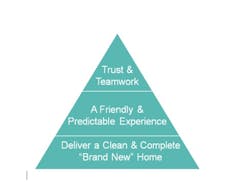How to Encourage More Referral Sales
Kate walks into her colleague Sara’s office and sees a floor plan and diagram on the wall. “Sara, what’s this? A new house?” Kate asks.
“Curt and I are building a new home!” Sara says.
Kate hears excitement in Sara’s voice. But she says, “I’ve heard so many new-home horror stories.”
“No worries,” replies Sara. “We bought a new house by Harbinger Homes that’s being built. This is our floor plan, and this diagram is the Pathway that outlines the home building process, with milestones and the names and contact info of our Harbinger Homes team. It’s funny; we haven’t needed to contact them. Our salesperson and project superintendent call us every week to give an update. It’s incredible.”
“How did you hear about Harbinger Homes?” Kate asks.
“We shopped several builders and were down to just a couple,” Sara says. “Then, one day at lunch, Jake from accounting overheard me talking about builders, mentioned Harbinger, and gave me a contact. Boy, are we happy he did.”
Sara’s enthusiasm is evident. “Our salesperson, Chris, is great. He says almost half of Harbinger’s new homeowners come from word of mouth. That says a lot, don’t you think? After we signed the paperwork, Chris gave us three copies of our house plan and the Pathway to Ownership diagram—I have one here on my wall, there’s one for our refrigerator, and the third is for Curt’s office.” Pointing to the Pathway, Sara effuses, “We’re here, and our pre-construction meeting is this Thursday. We can’t wait.”
Kate comments, “You know, Randy and I were thinking we might like a new home someday soon ...”
“Look right here on the Pathway!” Sara points to a red tree on the schematic. “It’s called a Kinship Tree. When a homeowner refers a friend to Harbinger, the new owner and the referring one each get a Japanese maple tree planted in their yard to commemorate the referral, the friendship, and the home. Jake is getting a Friendship Tree, and we’ll get one, too.”
The following weekend, Kate and Randy go to see Chris at Harbinger Homes.
Create a Companywide Referral-Supportive Culture
The scene just described is based on a true story. Getting there involves hard work, but it does happen. First, it comes from a companywide commitment to change and to operational excellence so consistent that it nets a high level of enthusiasm from customers. Second, a consistent flow of referrals demands dedication to being a referral sales-minded builder with a proactive strategy. Again, it’s a lot of work, but it can produce more than 40 percent of your sales—forever.
Culture change is challenging, but the rewards are worth it. Consider Atlantic Builders, in Fredericksburg, Va. Tom Schoedel, president, says that Atlantic was always a good builder, but that the company took it to the next level by growing a customer-centric culture, and he has the new-homeowner statistics to prove it. “We always cared about our buyers, but we didn’t have a Customer Experience Plan,” Schoedel says. “At first we had to learn it, now it’s second nature and part of the culture of our team, company, and being.”
Hierarchy of Needs
The kind of culture change we’re talking about starts with these two steps:
1| Take a look at where your company is now.
You can’t know if you’re winning if you don’t keep score.
• How many of your sales come from customer referrals?
• Which members of your sales team regularly generate referral sales?
• Have you determined if you have customers who are referral stars—who have referred multiple potential buyers?
• Are you even tracking referrals?
A correctly executed Voice of the Customer (VOC) program is a step toward this objective scoreboard.
2| Make sure your company earns referrals.
Use the standard pyramid of totally satisfied customers that’s inspired by psychologist Abraham Maslow’s hierarchy of needs, developed in the 1940s. Ensure customer satisfaction by offering:
Clean and complete homes: This is the foundation of meeting and exceeding customer expectations. Everything on the punch list completed, no construction debris left inside or out,
and the home is “brand new,” clean, and ready to move into by the final walk-through.
A friendly and predictable experience: A clear road map to teach proper expectations, which includes regular communication and guidance throughout. Regular communication is a powerful tool. After reading more than 500,000 customer surveys, I’ve never read a complaint that the builder called too much. Communications should be rebranded as “communicare”—the last five letters spell “I care.”
Trust via teamwork: Carefully define and teach expectations. Doing so as a team (salesperson and superintendent) becomes more powerful because teamwork becomes obvious. Teamwork Voice of the Customer (VOC) ratings are strongly correlated to future referral sales.
And, finally, make sure you have a feedback loop. Design a reliable system for continuously tracking VOC information with accountability, reward, and correction systems built in for successes and failures. “Referrals are a big part of our business,” says Maurie Jones, VP of marketing for Ohio-based Wayne Homes. “In some instances, we’ve built for three generations of a family. We try to ask every potential client who walks through our door if they know someone who built with Wayne Homes. Half of the time, the answer is yes.”
Build Referrals Into Your Home Building Company's Culture
A critical part of creating a referral-strong culture is to teach this to your customers as an integral part of your homebuying process. In the Harbinger story, referral sales seeds were planted early and often by each member of the team. Harbinger did a great job teaching the floor plan (the What) and the experience (the How) to Sara and Curt. Educating buyers on what to expect through each step of home building, combined with positive interactions with the team, created customer bonding to the house and the team in an emotional way. Both are key to fully accelerate referral sales. Harbinger also gave its homeowner a great tool, the Pathway chart, to help customers tell their referral story to family and friends. Here, they educated the buyer and scattered the seeds.
Monetary rewards to the customer may not be the best choice for a Referral Sales program; cash can turn a relational event into a transactional one, and that’s not good. Atlantic Builders offers a thank-you like Harbinger’s. In the Friendship Tree Program, the tree and a Giving Tree key ring are a warm reminder and thank-you with lasting emotional resonance.
Train Customers to Refer
Referring is a learned behavior. In order to be elicited, it must be asked for, and even taught.
Conaway Homes’ Brent Conaway, VP of sales and marketing, says that asking for referrals is an expected part of the interaction: “Everyone knows someone who needs a home, therefore, this is constantly a part of our conversations, even in the grocery store checkout line. Our customers can be our best or worst marketing resource.” In addition, “We hand out referral cards like candy,” Conaway says. “It’s a great excuse to generate conversations and discover opportunities.”
Woodland, O’Brien & Scott studied 2,000 homeowners across the U.S. Group A was comprised of homeowners who weren’t referred to their home builder. Group B consisted of homeowners who were referred by a family member or friend. Group B, those who were initially referred, ended up referring 4.25 prospects each, versus Group A homeowners, who referred, on average, 0.75 potential buyers each. Given that referral prospects convert to contracts at a 3:1 ratio, this is an opportunity loss of 1 gross profit (averaging $75,000) for every referral under 40 percent of your sales.
Prompt Continued Engagement With Customers
The planting of referral sales seeds isn’t finished after the sale. What are you doing to acknowledge your referring customers and keeping them engaged with your company? How about delivering a surprise pumpkin at Halloween? Or, inviting homeowners to a special pre-opening reception for new home models? Spend time creating effective and varied ways to let your homeowners know they still matter.
Your referral sales rate is much more than just a way to save money on marketing costs. It’s the most effective litmus test of your company’s leadership and operational excellence. Are your current customers happy enough with you to encourage others to trust you? Will they risk their reputation on yours? If the answer is yes, you’re doing well. If the answer is no, you’re losing a lot of integrity and gross profit.


